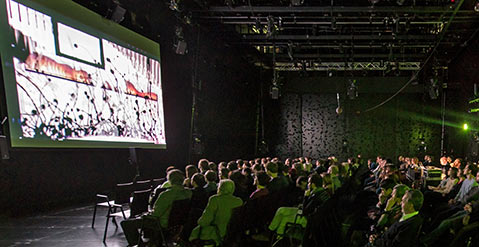Dr. Curtis Roads Wins 2016 Giga-Hertz Award
UCSB Composer and Researcher Praised for Electronic Music Innovations

Imagine, in your ear space, a tiny sound, a millisecond-long fraction of which is then cloned and repeated into a spray of smaller sound particles, all piled upon each other in a moment of time, similar to grains of sand slipping through the fingers, all distinct in suspension and then enveloped together once more.
If you can picture this, you can conceive the revolutionary process of granular synthesis pioneered by UCSB professor and electronic music pioneer Dr. Curtis Roads, who in December of last year was awarded the 2016 Giga-Hertz Award, a prize given to individuals who have made lasting contributions to electronic music and culture in general.
For decades, Roads has explored how compositional techniques can be expanded through periodic sound impulses sampled, stretched, and crisscrossed in fragments of time, leading to never-before-heard frequencies. While concepts such as granular and pulsar synthesis are perhaps not part of the average listener’s lexicon, Roads’s influence can be heard all across the world of popular electronic music, with acts such as Autechre and Aphex Twin employing his innovations in their work.
Roads had no idea he was in the running for the €10,000 prize and only found out via email that he had won. “It came out of the blue. It is an honor, and I am very grateful,” he said. Following the ceremony, sponsored by Germany’s Zentrum fur Kunst und Medientechnologie (ZKM) and the Experimentalstudio des SWR, Roads performed in Graz, Austria, with a 29-speaker setup and visuals by Brian O’Reilly. While in Europe, he received yet another unexpected honor, this time from ZKM’s director, who offered to publish Roads’s and O’Reilly’s collaborations. Roads envisions a Blu-ray with new high-resolution video and audio.
Roads remembers his first explorations into granular synthesis when it was written on punch cards and calculated on a large mainframe computer. “I still recall a sunny day in La Jolla in December 1974 when I heard my first granular synthesis experiment by means of a DEC-PDP/20 computer and a custom, 12-bit, digital-to-analog converter for sound. I felt at that time that I was onto something,” he said. It was an exhaustive process, one unimaginable perhaps to natives of today’s rapidly quick software such as GarageBand and Pro Tools; Roads’s results could take days to process. To get a sense of how cool it all is, think of the limited amount of sounds and notes offered in traditional acoustic piano composition, for example. Roads’s experiments helped forge the way for musicians to utilize an infinite variety of sounds beyond the classical scales of time and notation. “The realm of electronic sound is a vast universe of uncharted territories,” he said.
“I am grateful to my teacher — the polymath genius, composer, architect, and engineer Iannis Xenakis — who conceived of this approach,” Roads said. He has continued his research at UCSB, where he works with fellow sound explorers such as Dr. JoAnn Kuchera-Morin, who oversees the Allosphere, an immersive and complex three-story instrument — a version of which will appear at the soon-to-open MOXI, The Wolf Museum of Exploration + Innovation. Roads is currently delving deep into the world of subharmonics — “the ratios below the fundamental frequency.”
“If being influential means to touch, move, and inspire, then I am proud to be of service,” Roads said of the honor. Congratulations, and here’s to more innovations and explorations into the infinite world of synthetic sound.



